---------------------------------------------------------
Setting up your rabbit area outdoors allows your rabbits to live a more natural life with lots of room to run and dig. But it’s very important to take precautions to keep your bunnies safe and comfortable. Let’s take a look at the basics for a good rabbit space.
The Rabbit Hutch or House
A good rabbit hutch/house is vital to your rabbit enclosure. A rabbit hutch is a secure place your rabbits can sleep at night or a safe space where they can retreat. It is their home base, and where you will likely keep their food, water, & hay. A hutch is generally smaller and good for 2-3 rabbits. If you have more rabbits, you will want a small shed, barn, or coop to house your rabbits.
The ideal rabbit hutch is a minimum of 6-7 feet long by 2 feet wide. Your rabbit should be able to take a few hops across the length of his hutch. He should also be able to stand up on his back feet without hitting his head, so it should be at least 2 feet tall. If you are keeping multiple rabbits in the same hutch, go as big as you can to give them plenty of space. If you have more than 3 rabbits, it’s best to skip the hutch and give them a larger shed, barn, or coop to live in. Being able to walk into your larger rabbit house will make cleaning easier. Click here for a more in-depth view of my first rabbit area with a hutch. Click here to view my current rabbit area inside my barn.


Hiding places
There should be a space with solid walls that is enclosed where they can “hide”. If the hutch or home is all wire with no private space, your rabbit is going to feel very exposed, especially when it’s dark. Rabbits in the wild live in cozy, underground burrows. Without their safe space, they will be stressed and will probably have a hard time sleeping. The enclosed space will provide a place for them to escape the weather. Make the enclosed space cozy with hay or straw to snuggle in or even add some old blankets or a cat bed.
Protection from the elements
If you live where it snows or if you get a lot of rain, your hutch should be raised off the ground and provide protection from falling precipitation with a solid roof. You can build a simple base to raise up your hutch – click here to read how we built our rabbit hutch base. Even if you don’t live where extreme weather is a problem, raising the hutch provides another step in predator protection and makes rabbit chores easier on your back.
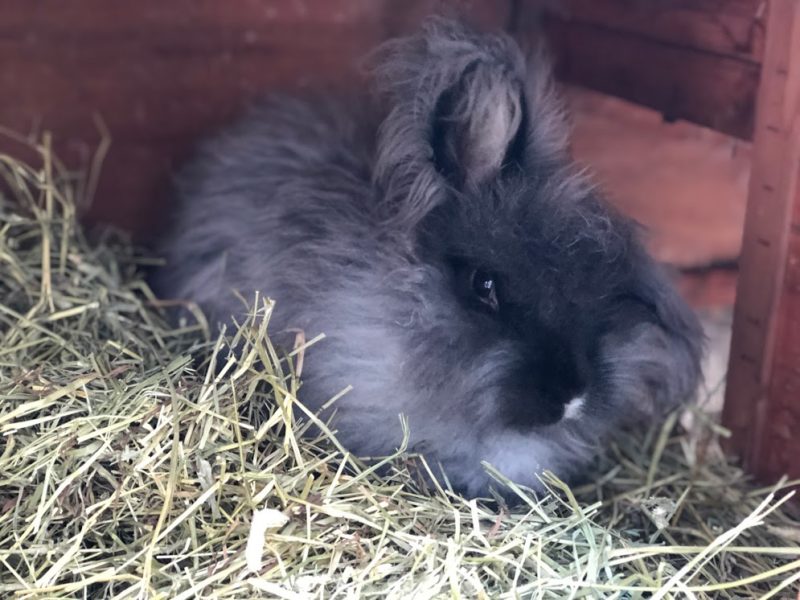
Install duel locks on all doors to the hutch/house
Some predators, like raccoons, have deft little hands and can manage simple locks. Having two different kinds of latches ensures they aren’t going to get in. Around dusk each night, you will need to go outside and lock the rabbits in their house. You can open them up in the morning. This keeps them safe during the highest predator time.
Locate the hutch/house out of direct sun
Rabbits can handle cold much better than they can handle the heat. When temperatures get over 85 degrees, rabbits can experience heat distress and can even die of heat stroke. It’s vital to give them shaded places to relax. Consider planting some bushes or trees nearby, or install a shade sail or canopy over their play area. In a large shed or barn, adding a barn fan can help keep the air moving.
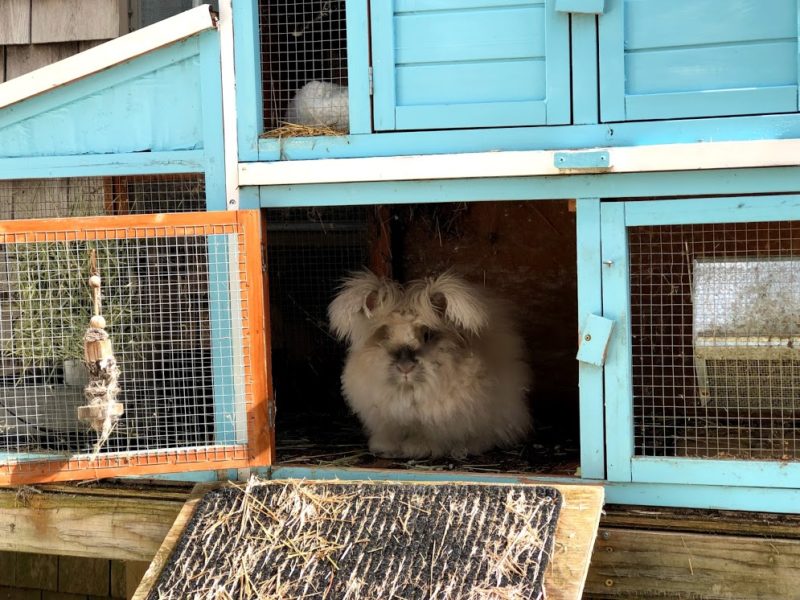
At least some of the hutch floor should be solid
Many people like to install wire floors in their rabbit hutch so the poop can fall through the holes to keep the hutch clean. That is great for the human caretakers but isn’t great for the rabbit’s feet. When rabbits walk on wire, it puts pressure unevenly on their pads and makes them carry their weight awkwardly even when resting on all fours. This can lead to sore hocks, and left untreated could cause a deadly infection. Click here to read more about sore hocks.
I have read horror stories about predators pulling at the rabbit’s exposed feet from under the wire floor trying to get to them. That’s another reason to give them some solid flooring! If you want to use wire flooring in part of the hutch that is fine, just be sure there are parts of the hutch where the rabbit can rest on solid flooring. The floor of our rabbit barn is covered with heavy-duty foam interlocking mats (like you would find under gym equipment).

Rabbit care equipment
You will want to supply the hutch/house with water, a feed bin, hay manger, and possibly a litter box. It is important your rabbit has access to food, water, & hay at all times so putting it in their hutch makes the most sense. Hang them in places that will be easy for you to access for cleaning & filling.
I like to hang the hay manger over the litter box so they can munch on hay while doing their business. It helps keep the area cleaner when they are litter box trained. Click here to read more about litter box training rabbits. During the winter, it is helpful to swap out the water bottle for one that plugs in and has a small heater to keep the water liquid. Having electricity in your rabbit enclosure is convenient, but you could also run an outdoor extension cord to the area.

The Exercise Yard
The hutch is important for keeping your bunny safe and cared for, but the exercise yard is where they will really want to spend most of their time! click here to read more about colony raising rabbits
32 square feet per rabbit is the minimum recommended space. The more space you can give them, the better though! Just make sure you don’t give them a space too big that you have a hard time properly securing it.

Hardware cloth for protection
Rabbits are diggers. They will dig all kinds of holes & tunnels in their exercise yard, so just putting a fence around the space isn’t going to cut it. You will want to dig down two feet and bury a wall of hardware cloth wire. Do this around the entire perimeter of the yard. The other option would be to line the entire floor of the enclosure with hardware cloth, then add straw or dirt on top. The rabbits won’t be able to dig holes for fun, but it is the safest option.
If possible, it is best to fully enclose your rabbit exercise yard. Think of it like a screened-in porch (but with solid hardware cloth wire, not screens). Making it 6 feet tall will make it comfortable for you to walk in and visit with your rabbits and for cleaning.
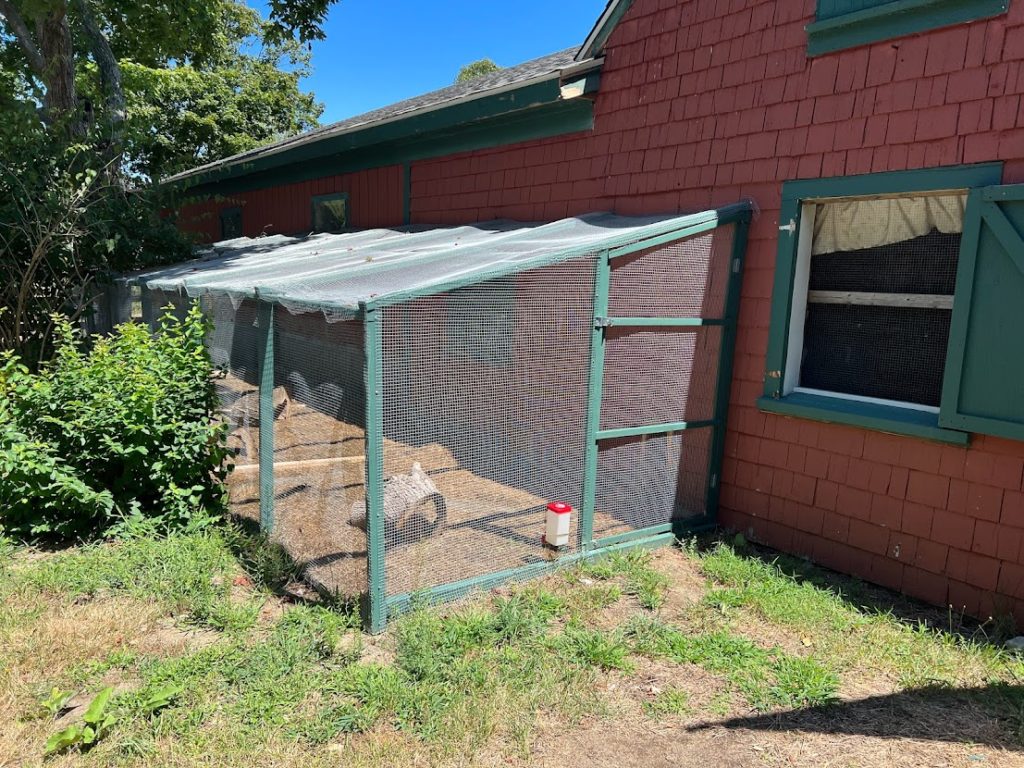
Weatherproofing
Putting a solid roof on the yard will make it so the rabbits can enjoy the yard even when it’s raining or snowing and will provide some shade from the summer sun. It will protect your rabbits from aerial predators like hawks. A solid roof will also make it more pleasant for you to get your daily rabbit chores done even in the rain. In the winter we wrap our exercise yard in plastic so it doesn’t fill with snow and to block the wind.
Ideally, your rabbit will have access to their exercise yard all day long and just be locked inside at night. This might not be practical for your setup if it is not totally predator-proof or weatherproof. At the very least they should be allowed a few hours in the exercise yard daily unless their indoor area is really large (inside a shed or barn).
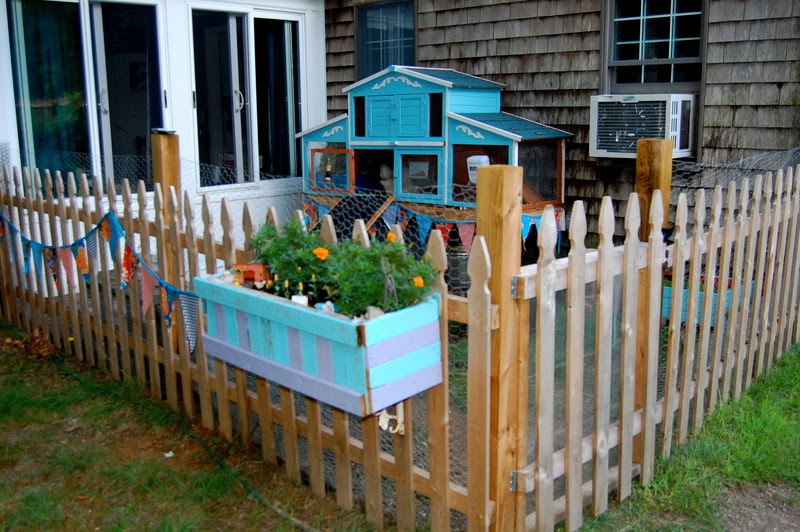

Space for digging
One of the best advantages to letting rabbits live outside is that they can dig to their heart’s content without destroying your home. So leave them lots of space for digging. Inspect the holes every day. When the rabbits get too close to the fence line, fill in the hole just in case. If they make a tunnel that has gotten too long (over 4 feet or so) I would also collapse it so it doesn’t accidentally collapse on them or on you if you walk over it. Our current enclosure has a full hardware cloth floor. It is more secure but they can’t dig giant burrows. I like to give them large boxes of straw or paper litter to dig in.
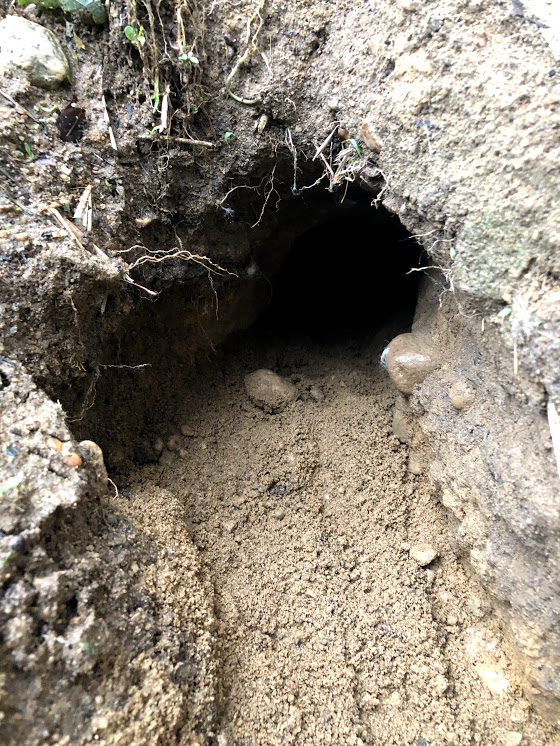
Places to hide, things to jump on, in or through
Rabbits like to keep busy so providing them with things to do will keep them happy! We have hollowed-out logs for them to jump on and hide under, wood boxes for hiding, planters with rabbit-friendly plants, and plastic tunnels.

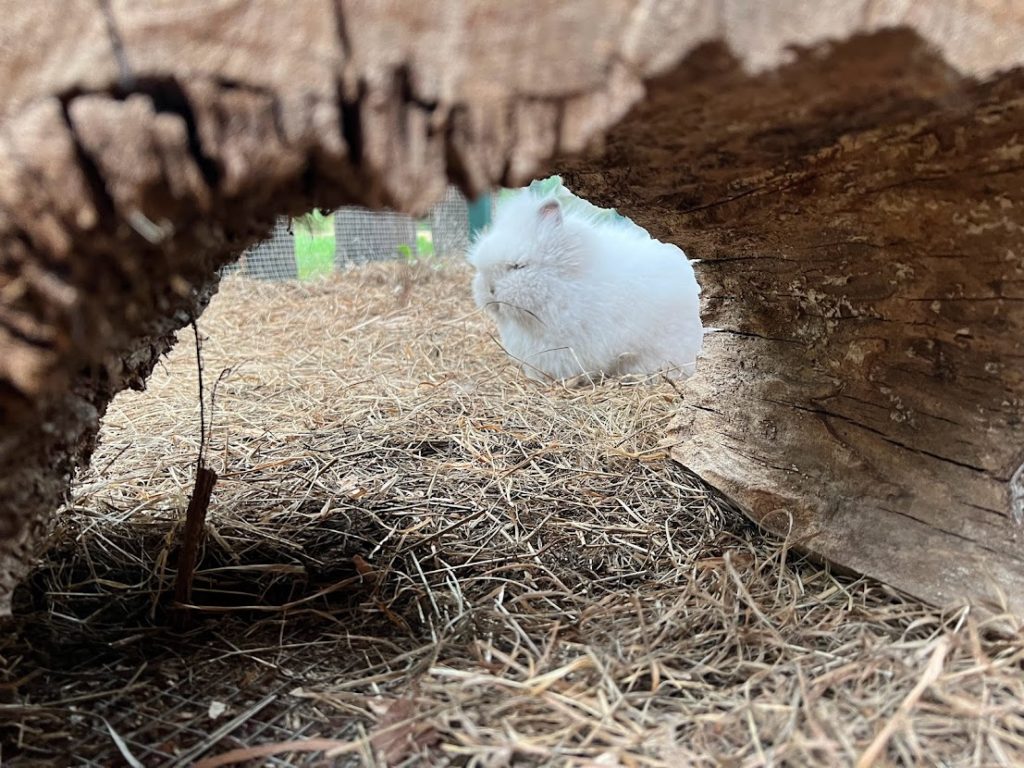
Benches or chairs – If you have a comfortable place to sit and enjoy your bunny’s company you will be much more likely to hang out with them!

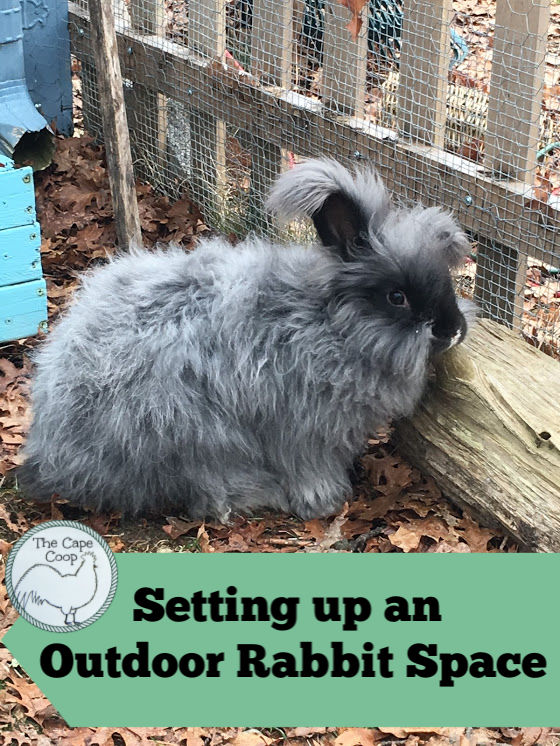

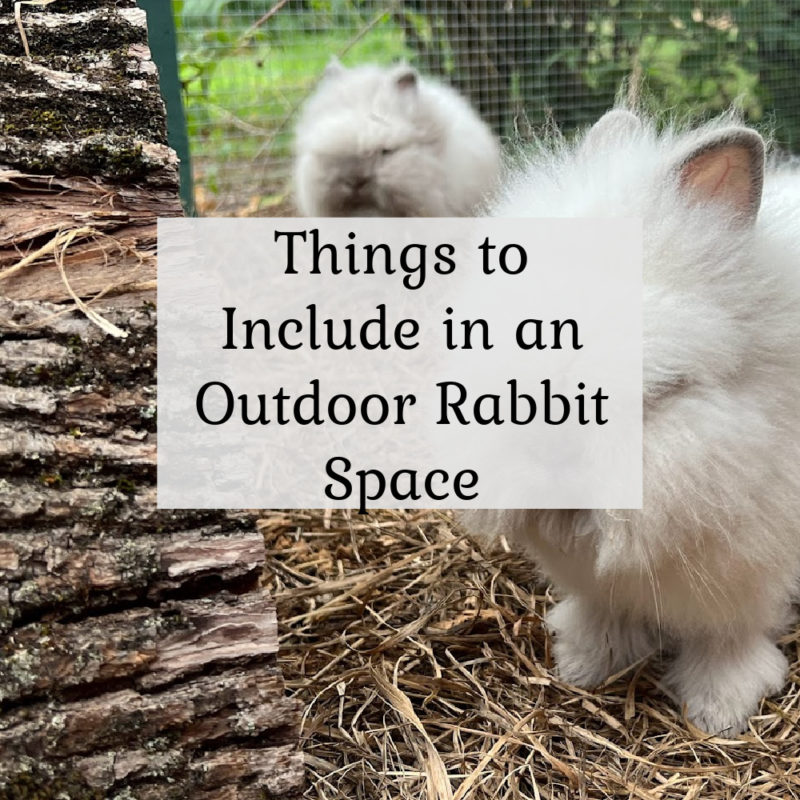

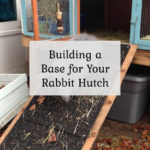
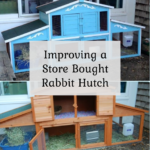
Robert
Friday 11th of August 2023
What do you do about flys and keeping the pen clean? We just installed a 4'x6' hutch with 6' high roof and a fenced playpen. The floor has construction netting that will keep predators out, but I am wondering about flies and other tiny pests. Thanks.
Liz
Wednesday 16th of August 2023
During fly season we hang up fly bags just outside of the pen and it has been quite effective. We also have a fan running in the summer all the time (flies don't love moving air), and we buy fly predators monthly to add to our farm compost pile (they are tiny bugs that eat fly larvae, which are often laid in compost areas)
Lori
Tuesday 25th of July 2023
Hi! Thanks for sharing! How or why do your boys get along?
Liz
Tuesday 1st of August 2023
I think the key to keeping unaltered males together is making sure they have enough space. My boys have 100 square feet inside and another 75 square feet outside available year round. That seems to be enough for 3 boys - we have had up to 5 briefly when we had a few younger boys that were too old to be with mom but hadn't found homes yet and there were a few chasing fights going on and even a little nipping. Providing different levels for exploring and places to hide is also a good idea. When introducing new boys to the space you want to give the older boys plenty of time to get used to it by keeping the new boy separated by wire so everyone can see and smell each other but not get to each other. Let them live like that for a few weeks until you see them relaxing by the wire border together. Once they are introduced properly my boys get along fine, they hang out together and groom each other. It is normal to see occasional acts of dominance (mounting) but that shouldn't be causing any injury to anyone.
Caroline
Wednesday 21st of September 2022
Hi, we have a rabbit hutch outside and we let them run outside during the day but I would like to build them a run to attach to the cage so they can roam a bit more freely - some questions 1) What is the material that is used to cover the ramp for exiting the hutch? 2) Can you cover the outside part with tarpaulin so it is covered but you can remove (wondering if this may be a cheaper starting point?!) I have a 4ft high wire enclosure (like the ones you get for dogs) that I am going to start with - was going to bungee cord some tarpaulin to it - thoughts? 3) I have some concrete slabs in my back yard, I was thinking of lining the edge with this so they don’t dig near the edge but can dig in the middle part if that makes sense? Watching my rabbits (i have 2 chinchilla rabbits) they seem to like to dig a little in the ground and lay in it to cool off so i don’t want to take the ability to dig away completely.
Liz
Thursday 29th of September 2022
em -That is great, I am sure they will love having more space to run. 1)our ramp has an outdoor mat attached to it for traction. but we also have another ramp that just has strips of wood attached horizontally for "steps". The rabbits do well with both ramps 2) during the day your main predators are likely to be birds of prey, so a tarp roof should be alright to start. I would definitely not recommend that if you leave them outside after dusk when other predators might be coming out 3) they LOVE to dig so if you can give them some space to dig they will absolutely love it. That set up should work fine as long as you keep an eye on any tunnels they start to construct. You can always let them start to dig tunnels but fill them in before they get big enough that they might tunnel under the concrete
KB
Sunday 24th of April 2022
Hello! Really enjoy your site and pics. I had a question about the safety of the wood used for hutches. I read that fir/Chinese fir (commonly used in many of the hutches you can find on Amazon and other online retailers) is toxic to rabbits. Would love your opinion on this. Thank you!
Liz
Tuesday 26th of April 2022
I was just reading about this the other day! I need to do some more research, but it does seem like most of these prefab hutches are made with Chinese Fir. Regular fir doesn't seem to be toxic, but Chinese Fir is a misleading name as it is not actually from the fir family, it is a type of cedar and most cedar is toxic to rabbits. Since writing this post we have moved and now have a barn for our rabbits so this hutch is just used for growing out chicks now, but we did use it for 5 years for rabbits with seemingly no ill effect. My rabbits didn't really chew on the hutch though. But I always think it's better safe than sorry so if you are in the market for a new hutch I would avoid any made with Chinese Fir
Megan Candora
Saturday 12th of February 2022
Do you not fine the need to cover the top of their outdoor pen? We are about to get two baby Flemish Giants and keep them outdoors. I'm building them an 8x8 run with fence posts and small gauge wire. I'm going to bury wire on the bottom as well and then cover it in topsoil and plant timothy grass for them. We have chicken hawks etc around our house so my husband is concerned with them carrying them away. Also, how often do you find you need to take your rabbits to the vet? That's another concern we have. I never took my rabbits to the vet as a child, but it appears that's a thing now??
Liz
Monday 14th of February 2022
It is definitely better to have a fully enclosed area. I felt safe with this set up because it was bordered on two sides by the house and we could keep an eye on them and predators generally don't come right up to the house. But we have since moved and have built an outdoor enclosure that has a wired ceiling (i'll have to update the post with new pics!). It certainly is much safer, because we do also have hawks. As far as the vet goes, you will find different opinions from different people. Many people take them in yearly for an annual check up as you would dogs and cats. Depending on where you live, rabbits don't need annual vaccinations however, so it is just a wellness check. It's important to note however that in some areas of the world there are vaccinations available that rabbits should have, for example in the UK rabbits should have an annual vaccination for rabbit hemorrhagic disease, but that is not available in most of the US because it is not an issue here. So it might be wise to take your bunnies to the vet when you first get them to ask about regional concerns, and just so you can be established as a client. I have kept rabbits for 7 years and I have had to take them in a handful of times for various illnesses, but in general they are pretty hardy animals! If you take them to the vet or not, you should spend time daily observing and doing a mini wellness check. Eventually you will know when something seems off and can act quickly. Once a month I also weigh each rabbit when I am clipping their nails and keep a health log